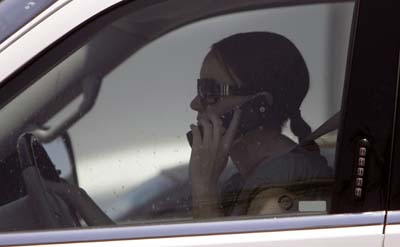Starting today, adult drivers will be fined a minimum of $20 for
using a handheld wireless telephone.
Feel like paying $20 for a phone call? If not, put down that phone and pay attention to the road.
Starting today, adult drivers will be fined a minimum of $20 for using a handheld wireless telephone. Motorists who can’t help but use their commute as a chance to catch up on the phone will have to purchase a hands-free device or keep quiet.
“If you’re going to use a cell phone while driving, it must be in a hands-free manner,” said California Highway Patrol Public Information Officer Chris Armstrong. “People do all kinds of things as they drive – reading, eating, putting on makeup, reaching for the radio – that take their attention away from the roadway. Many vehicle collisions are a result of distractions like these. Phones are a distraction that will hopefully be eliminated.”
In fact, an estimated 300 to 900 lives will be saved annually statewide once California’s hands-free cell phone laws go into effect, according to research conducted by the Public Policy Institute of California, State Sen. Joe Simitian, D-Palo Alto, stated in a May press release.
“Cell phones are the number one cause of distracted-driving accidents in California,” Simitian said. “The difference between hands-free and hand-held is the difference between life and death.”
The new law requires adult drivers to use a hands-free device and drivers under 18 to abstain from talking on the phone at all. Violators will be penalized with a $20 base fine for the first offense and $50 fines for subsequent offenses, plus additional fees that could more than triple the base fine. Although the violation is a reportable offense, the Department of Motor Vehicles will not assign a point to an offending motorist’s driving record. Law enforcement agencies – city police, CHP and sheriff’s deputies – will treat the offense like any other traffic violation and plan to begin enforcement first thing this morning.
“Any citation is open to the discretion of the officer,” Sgt. Jim Gillio of the Gilroy Police Department said. However, police are not obligated to issue warnings before handing out citations, he said.
“We can and will stop for it,” Armstrong said.
“(Drivers) can be pulled over just for talking,” agreed Sgt. Don Morrissey of the Sheriff’s Office.
In Hollister, opinions were split on whether people would actually adhere to the new cell phone restrictions. Manuela Lopez of Hollister said she believed people would obey the law and thought it would save drivers some of the “distraction” of using a phone while driving.
“I use my cell phone in the car but I’ll stop,” she said. “Usually I just let it go to voicemail or have one of the kids answer. I may get a Bluetooth set, but we’ll see.”
But Yoshio Astudillo of Hollister said he thought people would keep talking on their phones while they drive and they would just be on the lookout for police.
“I think the majority of people will still be talking while they drive,” he said. “Some may put it on speaker phone or get a hands free but if they have to make a call, they’re still going to make it.”
While drivers younger than 18 can’t talk or text behind the wheel, adult drivers are still able to text while driving, although they are strongly discouraged, Armstrong said. Texting can be just as dangerous as talking on a cell phone, he said.
Friday afternoon, a steady stream of customers filtered into the Gilroy Verizon store on Camino Arroyo to buy hands-free headsets or have an employee give them a quick tutorial on their new purchase.
Pam and Gian Rossini asked an employee for a lesson on how to use the voice activated calling feature on their cell phones, an element that allows the caller to say the person’s name they want to call, rather than dialing. Technically, drivers are not prohibited from dialing out on their cells but the couple agreed that using the keypad was one of the most dangerous aspects of using their cell phones.
Most cell phones have this feature, which isn’t difficult to set up, said Chris Short, assistant store manager at the Gilroy Verizon store. Just that morning he had sold more than a dozen hands-free devices and taught several to use their voice activated calling feature. The devices range from $15 to $130, depending on sound quality, comfort and durability.
“It’ll be a new experience,” said Pam Rossini, her Jawbone Bluetooth device fresh out of its package. “I’m becoming legal.”
Although she doesn’t care for cell phones and refrained from using hers as much as possible while driving even before the law took effect, she couldn’t say the same for her husband, who used his cell often while driving for his job. She also couldn’t vouch for her husband’s adeptness at maneuvering a vehicle while holding a phone. He said he could recall more than one case of distracted driving while talking on his phone.
“It’s a great law,” said Gian Rossini. “It forces people to pay attention.








